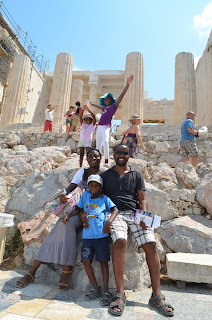We were tired but wanted to get in the Acropolis Museum as well. Little did we know how Amaka would love the Museum, especially about the ancient gods. Her year-long readings on Greek mythology came to life! She saw all, educated us about some of these gods and did not want to go. The best fun she has had in the museum, she said. Worth the effort!!!
Who else was here? The Apostle St Paul. Acts 17: 16-34. His dramatic and forceful argument here "with with people who used their time for nothing else but telling and hearing something new" gives us great insight into what he faced. (The areopagus is a section of the Acropolis.) His account, in addition to showing Paul's work, also confirms this place as the intellectual capital of the ancient world.
We first stopped by the Temple of Zeus - which was built bigger than the Parthenon and completed by Emperor Hadrian.
The Temple of Zeus
Hadrian's arch
Built in 5 Century BC, the Acropolis (meaning "High City") towers overs Athens. It is the womb of modern civilization. Ancient philosophers, drama and democracy all found their roots here. It is a hike going up the place, taking the better part of 4 hours. During the hot summer months of Athens, a walk can be very challenging. In retrospect, our 2011 hike to St. Nikolas near Alhambra, Granada, Spain prepared us for a day like this.
In an attempt to preserve/restore the place, some of the original structures have been affected.
Theater of Dionysos
The first drama theater built of stone and the birthplace of Greek tragedies. As the guide in front of us said - " The beginning of theater"
Taking a break in the shade
The Odeon of Herodes Atticus - Built in 2nd century AD, it is still in use today for concerts
Propylaia: the grand entrance to the Acropolis.
Built in 421-401 BC, this is the most sacred site in the Acropolis. It is where Athena's olive tree sprouted, giving her possession of the city. During the Turkish reign (1463), it served as a Harem for wives of Turkish commanders. It was destroyed by Turkish shelling in 1827 during the Greek War for Independence.
In front of The Parthenon, the loftiest point of the Acropolis. Dedicated to the goddess Athena, some of the items recovered from here are preserved in the Museum.
Atop the Acropolis with great view of the City
Temple of Athena Nike, commemorating the Greek's victory over the Persians in 421 BC
At the Acropolis Museum
The frieze about Poseidon and Athena, and the birth of Athena, all the characters on the frieze.
Our resident Greek Mythologist inspecting...
Ready to call it a day!!
On our way to the Acropolis, we passed the Kallimarmaro Stadium, the site of the first modern Olympic games of 1896! It sits on the exact site of the original Panathenaic Stadium built in 330 BC.
































No comments:
Post a Comment